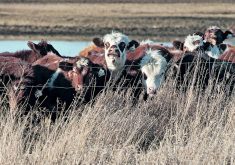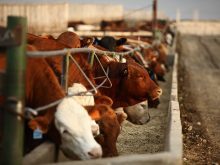In the week ending May 25, Western Canadian feeder cattle markets were trading $4 to $8 higher compared to seven days earlier. Some higher quality genetic packages of 700-pound plus cattle were up as much as $10 from week-ago levels.
Pen conditions are rated poor to very poor in many regions of Western Canada, but this didn’t stem buying interest. Order buyers reported full decks across all weight categories. Certain finishing operators who were quiet over the past month came out in full force this past week. Alberta orders stretched across the Prairies and stepped up competition from Ontario and U.S.
Read Also

U.S. grains: Corn and wheat futures firm on brisk exports, softer dollar
U.S. corn and wheat futures firmed on Thursday, supported by brisk export sales and a softer dollar, which tends to make U.S. grains more competitive globally, analysts said. Soybean futures clung to modest gains.
Demand for grassers is stronger than past years because most of Western Canada has received more than 200 per cent of normal precipitation over the past 30 days.
There were only a few sales last week in Saskatchewan and Alberta. Lethbridge-area feedlots once again paid up for local cattle setting a minor premium to other regions. Feeding margins are hovering just above break-even with Alberta packers showing bids on a dressed basis at $432/cwt delivered.
South of Edmonton, medium to larger frame, light butter, mixed steers around 940 pounds, with full processing data traded for $314. In east-central Alberta, medium to larger frame black steers, carrying lower flesh levels, averaging 865 pounds sold for $338. At the same sale, larger frame tan steers weighing 840 pounds dropped the gavel at $352. South of Calgary, Simmental based 825-pound heifers on light grain and barley silage diet, with controlled flesh, weight gain diet were valued at $310 fob feedlot.
In east-central Alberta, the final bid for medium to larger frame, thin, Charolais steers weighing 710 pounds was $401. In the Red Deer region, a smaller package of larger frame red heifers on the card at 725 pounds, with full processing data silenced the crowd at $347.
In Southern Alberta, Angus blended weaned steers weighing a shade over 600 pounds touched the $430 level. Southeast of Edmonton, tan heifers averaging 610 pounds apparently sold for $378. In the same region, tan short-weaned steers weighing 515 pounds were valued at $480 and red heifers weighing 545 reportedly sold for $396.
For September delivery in Central Alberta, steers averaging 1,000 pounds off grass are quoted at $320-$325 and 1,000 pound heifers are valued at $300-$305. The feeder market is reflecting a $20-$30 premium between nearby and deferred values.
Good quality cow/calf pairs are trading upwards of $4800 while quality genetic bred heifers are reaching of $4,000 with expectation to trade up to $5,000 next fall. Current data suggests we’ll see a year-over-year decline in the U.S. calf crop for 2024 and in 2025 and this is driving the replacement market.
— Jerry Klassen is president and founder of Resilient Capital, specializing in proprietary commodity futures trading and market analysis. Jerry consults with feedlots on risk management and writes a weekly cattle market commentary. He can be reached at 204-504-8339 or via his website at ResilCapital.com.















